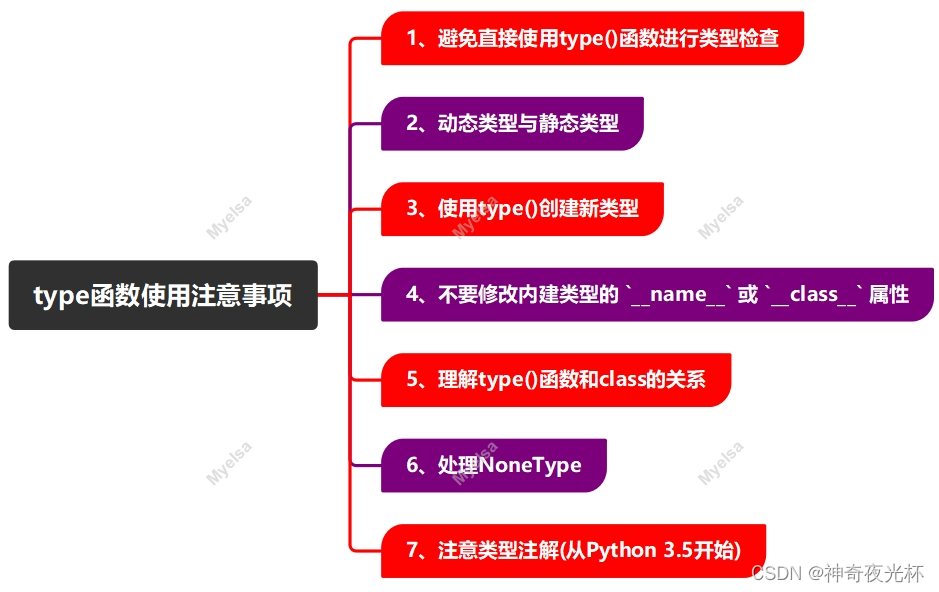目录
一、type函数的常见应用场景
二、type函数使用注意事项
三、如何用好type函数?
1、type函数:
1-1、Python:
1-2、VBA:
2、推荐阅读:
个人主页: https://myelsa1024.blog.csdn.net/



一、type函数的常见应用场景
type函数在Python中有多个实际应用场景,尽管它主要用于获取对象的类型,但在某些特定情况下,它也能提供重要的信息或用于编程的某些方面,其常见的应用场景有:
1、类型检查: 当你需要确保某个变量或对象具有特定的类型时,可以使用type()函数进行检查,这在编写函数或方法时特别有用,尤其是当函数需要特定类型的参数时。
2、动态类型判断:在某些情况下,你可能需要根据对象的类型来执行不同的操作,使用type()函数可以帮助你实现这种动态类型判断。
3、反射和元编程:在需要编写能够处理不同类型对象的通用代码时,可以使用type()函数和相关的元编程技术。例如,你可以检查一个对象的类型,并基于该类型调用不同的方法或执行不同的操作。
4、注册和类型映射:在构建大型系统时,可能需要将对象类型映射到特定的处理函数或类,type()函数可以用于实现这样的类型到行为的映射。
5、工厂函数和类工厂:在需要基于输入参数动态创建不同类型对象的情况下,可以使用type()函数作为类工厂,这在实现复杂的工厂模式或元编程时可能很有用。
6、调试和日志记录:在开发过程中,type()函数可以帮助你确定变量的实际类型,这在调试或记录对象状态时可能很有用。
7、与其他类型系统交互:当与需要明确类型信息的外部系统或库交互时,type()函数可以帮助你提供正确的类型信息。
8、与内建类型进行比较:有时你可能想要检查一个对象是否是某个特定的内建类型(如int, str, list等),虽然isinstance()函数是更推荐的做法,但type()函数也可以用于此目的。

二、type函数使用注意事项
在Python中使用type()函数时,请注意以下几点:
1、避免直接使用type()函数进行类型检查:虽然type()函数可以用来检查对象的类型,但在实践中,更推荐使用isinstance()函数来进行类型检查,这是因为isinstance()会考虑子类关系,而type()则不会,如果你的代码期望接受某个类或其子类的实例,使用isinstance()会更加灵活和健壮。
2、动态类型与静态类型:Python是一种动态类型语言,这意味着变量的类型可以在运行时改变,因此,过度依赖type()函数进行类型检查可能并不符合Python的哲学,在编写Python代码时,应该尽量利用动态类型的优势,而不是试图强制所有变量都保持固定的类型。
3、使用type()创建新类型:虽然type()函数可以用于在运行时动态地创建新的类型,但这种用法在Python中并不常见,Python提供了更直观和易于理解的class语法来定义新的类型,这在大多数情况下都是首选的方法。
4、不要修改内建类型的 `__name__` 或 `__class__` 属性:尽管Python允许你修改对象的属性,但你应该避免修改内建类型或对象的 `__name__` 或 `__class__` 属性,这些属性在Python的内部机制中扮演着重要的角色,修改它们可能会导致不可预测的行为或错误。
5、理解type()函数和class的关系:在Python中,type()函数实际上是一个内建的元类,它负责创建和管理类,当你使用class关键字定义一个类时,Python会自动使用type()作为元类来创建这个类,理解这个关系有助于你更深入地理解Python的类系统。
6、处理NoneType:当你使用type()函数检查一个值为None的变量时,它将返回<class 'NoneType'>,确保在代码中正确处理这种情况,特别是当你期望某个变量可能是None时。
7、注意类型注解(从Python 3.5开始):虽然类型注解(如 `def foo(x: int) -> str:`)并不会改变Python 的动态类型特性,但它们为代码提供了额外的类型信息;类型注解主要用于文档、类型检查和可能的静态类型分析,type()函数与类型注解没有直接关系,但在编写和阅读带有类型注解的代码时,你应该意识到这些注解的存在和用途。

三、如何用好type函数?
type()函数在Python中用于获取对象的类型,这个函数非常有用,尤其是在你想了解某个对象的类型,或者你想根据对象的类型来执行不同的操作时。为了用好type()函数,请遵循以下建议和方法:
1、获取对象的类型:使用type()函数可以轻松地获取任何对象的类型。
2、判断对象的类型:你可以使用type()函数来判断一个对象是否属于特定的类型,但是,通常建议使用内置的isinstance()函数来进行类型检查,因为它支持子类检查(即如果对象是某个类的子类的实例,isinstance()也会返回True)。
3、在动态类型系统中使用:Python是一种动态类型语言,但type()函数仍然在某些情况下很有用。例如,你可能有一个函数,它接受一个对象并根据该对象的类型执行不同的操作。
4、与isinstance()函数结合使用:虽然type()函数可以用于类型检查,但isinstance()函数通常是更好的选择,但是,你可以结合使用type()和isinstance()两个函数来检查对象是否属于特定的元组或集合中的类型。

1、type函数:
1-1、Python:
# 1.函数:type
# 2.功能:
# 2-1、一个参数:用于获取对象的类型
# 2-2、多个参数:用于获取新的类型对象
# 3.语法:
# 3-1、type(object)
# 3-2、type(name, bases, dict, **kwds)
# 4.参数:
# 4-1、object:想要检查其类型的对象或变量
# 4-2、相关参数说明如下:
# 4-2-1、name:一个字符串,表示新类型的名称
# 4-2-2、bases:一个元组,表示新类型所继承的父类元组的集合(一个或多个)
# 4-2-3、dict:一个字典,其中包含定义新类型的属性的键值对
# 4-2-4、**kwds:一个额外的关键字参数,但在创建类时通常不使用
# 5.返回值:
# 5-1、一个参数:返回对象的类型
# 5-2、多个参数:返回新的类型对象
# 6.说明:
# 7.示例:
# 用dir()函数获取该函数内置的属性和方法
print(dir(type))
# ['__abstractmethods__', '__annotations__', '__base__', '__bases__', '__basicsize__', '__call__', '__class__',
# '__delattr__', '__dict__', '__dictoffset__', '__dir__', '__doc__', '__eq__', '__flags__', '__format__', '__ge__',
# '__getattribute__', '__getstate__', '__gt__', '__hash__', '__init__', '__init_subclass__', '__instancecheck__', '__itemsize__',
# '__le__', '__lt__', '__module__', '__mro__', '__name__', '__ne__', '__new__', '__or__', '__prepare__', '__qualname__', '__reduce__',
# '__reduce_ex__', '__repr__', '__ror__', '__setattr__', '__sizeof__', '__str__', '__subclasscheck__', '__subclasses__', '__subclasshook__',
# '__text_signature__', '__weakrefoffset__', 'mro']# 用help()函数获取该函数的文档信息
help(type)# 应用一:类型检查
# 示例1:使用type()进行类型检查
def check_type_with_type(obj, target_type):return type(obj) is target_type
# 示例
num = 123
print(check_type_with_type(num, int)) # 输出: True
string = "hello"
print(check_type_with_type(string, str)) # 输出: True
# 错误的类型检查(不建议)
print(check_type_with_type(string, list)) # 输出: False
# True
# True
# False# 示例2:使用isinstance()进行类型检查(推荐)
def check_type_with_isinstance(obj, target_type):return isinstance(obj, target_type)
# 示例
num = 123
print(check_type_with_isinstance(num, int)) # 输出: True
string = "hello"
print(check_type_with_isinstance(string, str)) # 输出: True
# 检查子类
class MyList(list):pass
my_list = MyList([1, 2, 3])
print(check_type_with_isinstance(my_list, list)) # 输出: True
# True
# True
# True# 应用二:动态类型判断
# 示例1:使用type()进行动态类型判断
def dynamic_type_check(obj):if type(obj) is int:print(f"The object is an integer with value: {obj}")elif type(obj) is str:print(f"The object is a string with value: '{obj}'")elif type(obj) is list:print(f"The object is a list with elements: {obj}")else:print(f"The object is of type: {type(obj)}")
# 示例
dynamic_type_check(123) # 输出: The object is an integer with value: 123
dynamic_type_check("hello") # 输出: The object is a string with value: 'hello'
dynamic_type_check([1, 2, 3]) # 输出: The object is a list with elements: [1, 2, 3]
dynamic_type_check(3.14) # 输出: The object is of type: <class 'float'>
# The object is an integer with value: 123
# The object is a string with value: 'hello'
# The object is a list with elements: [1, 2, 3]
# The object is of type: <class 'float'># 示例2:使用isinstance()进行动态类型判断(推荐)
def dynamic_type_check_with_isinstance(obj):if isinstance(obj, int):print(f"The object is an integer or a subtype of integer with value: {obj}")elif isinstance(obj, str):print(f"The object is a string or a subtype of string with value: '{obj}'")elif isinstance(obj, list):print(f"The object is a list or a subtype of list with elements: {obj}")else:print(f"The object is of type: {type(obj)}")
# 示例,包括自定义类(子类)
class MyString(str):pass
my_string = MyString("custom string")
dynamic_type_check_with_isinstance(123) # 输出: The object is an integer or a subtype of integer with value: 123
dynamic_type_check_with_isinstance("hello") # 输出: The object is a string or a subtype of string with value: 'hello'
dynamic_type_check_with_isinstance(my_string) # 输出: The object is a string or a subtype of string with value: 'custom string'
dynamic_type_check_with_isinstance([1, 2, 3]) # 输出: The object is a list or a subtype of list with elements: [1, 2, 3]
dynamic_type_check_with_isinstance(3.14) # 输出: The object is of type: <class 'float'>
# The object is an integer or a subtype of integer with value: 123
# The object is a string or a subtype of string with value: 'hello'
# The object is a string or a subtype of string with value: 'custom string'
# The object is a list or a subtype of list with elements: [1, 2, 3]
# The object is of type: <class 'float'># 应用三:反射和元编程
# 示例1:使用type()进行反射
class MyClass:def __init__(self, value):self.value = value
def reflect_on_object(obj):print(f"Object type: {type(obj)}")print(f"Object attributes: {dir(obj)}")
# 示例
obj = MyClass(42)
reflect_on_object(obj)
# Object type: <class '__main__.MyClass'>
# Object attributes: ['__class__', '__delattr__', '__dict__', '__dir__', '__doc__', '__eq__', '__format__', '__ge__',
# '__getattribute__', '__getstate__', '__gt__', '__hash__', '__init__', '__init_subclass__', '__le__', '__lt__', '__module__',
# '__ne__', '__new__', '__reduce__', '__reduce_ex__', '__repr__', '__setattr__', '__sizeof__', '__str__', '__subclasshook__', '__weakref__', 'value']# 示例2:使用type()进行元编程
def create_class_dynamically(class_name, base_classes=(), attrs={}):return type(class_name, base_classes, attrs)
# 示例:动态创建一个类
DynamicClass = create_class_dynamically('DynamicClass', (),{'x': 10, 'y': 20, 'display': lambda self: print(self.x, self.y)})
# 实例化并调用方法
instance = DynamicClass()
instance.display() # 输出: 10 20
# 验证类的属性
print(type(DynamicClass)) # 输出: <class 'type'>
print(DynamicClass.x) # 输出: 10
# 10 20
# <class 'type'>
# 10# 示例3:复杂的元编程示例--工厂函数创建类
def class_factory(class_name, class_attributes):methods = {k: v for k, v in class_attributes.items() if callable(v)}other_attrs = {k: v for k, v in class_attributes.items() if not callable(v)}def init_method(self, **kwargs):for key, value in other_attrs.items():setattr(self, key, value)for key, value in kwargs.items():setattr(self, key, value)class_dict = {'__init__': init_method}class_dict.update(methods) # 将方法添加到类字典中return type(class_name, (object,), class_dict)
# 示例:使用工厂函数创建类
Person = class_factory('Person', {'name': 'placeholder', # 这里使用一个占位符,将在初始化时设置'greet': lambda self: print(f"Hello, I'm {self.name}")})
# 实例化并调用方法
person = Person(name='John Doe', age=30) # 在这里设置 name 属性
person.greet() # 输出: Hello, I'm John Doe
print(person.name) # 输出: John Doe
print(person.age) # 输出: 30
# Hello, I'm John Doe
# John Doe
# 30# 应用四:注册和类型映射
# 定义一个类型到处理函数的映射字典
type_registry = {}
# 注册类型的装饰器
def register_type(type_class):def decorator(func):type_registry[type_class] = funcreturn funcreturn decorator
# 一个处理int类型的函数
@register_type(int)
def handle_int(value):print(f"Handling integer: {value}")
# 一个处理str类型的函数
@register_type(str)
def handle_str(value):print(f"Handling string: {value}")
# 一个处理类型并调用相应处理函数的函数
def handle_value(value):value_type = type(value)if value_type in type_registry:type_registry[value_type](value)else:print(f"No handler for type {value_type}")
# 使用示例
handle_value(123) # 输出: Handling integer: 123
handle_value("hello") # 输出: Handling string: hello
handle_value(3.14) # 输出: No handler for type <class 'float'>
# 如果需要,可以添加更多的类型处理函数
@register_type(float)
def handle_float(value):print(f"Handling float: {value}")
# 现在float类型也被处理了
handle_value(3.14) # 输出: Handling float: 3.14
# Handling integer: 123
# Handling string: hello
# No handler for type <class 'float'>
# Handling float: 3.14# 应用五:工厂函数和类工厂
# 示例1:工厂函数示例
class Animal:def __init__(self, name):self.name = namedef speak(self):pass
class Dog(Animal):def speak(self):return "Woof!"
class Cat(Animal):def speak(self):return "Meow!"
def animal_factory(animal_type, name):if animal_type == 'dog':return Dog(name)elif animal_type == 'cat':return Cat(name)else:raise ValueError(f"Unsupported animal type: {animal_type}")
# 使用工厂函数
dog = animal_factory('dog', 'Buddy')
print(dog.speak()) # 输出: Woof!
cat = animal_factory('cat', 'Whiskers')
print(cat.speak()) # 输出: Meow!
# Woof!
# Meow!# 示例2:类工厂示例
def class_factory(class_name, base_classes=(), class_attributes={}):return type(class_name, base_classes, class_attributes)
# 定义Animal类的通用属性和方法
def animal_init(self, name):self.name = name
def animal_speak(self):passAnimalAttributes = {'species': '','num_legs': 0,'__init__': animal_init,'speak': animal_speak
}
# 使用类工厂创建一个新的类
DogClass = class_factory('Dog', (object,), {**AnimalAttributes,'species': 'dog','num_legs': 4,'speak': lambda self: "Woof!" # 或者定义一个名为dog_speak的函数,然后引用它
})
# 实例化新创建的类
dog = DogClass('Buddy')
print(dog.speak()) # 输出: Woof!
print(dog.species) # 输出: dog
print(dog.num_legs) # 输出: 4
# Woof!
# dog
# 4# 应用六:调试和日志记录
# 示例1:基本的调试输出
def check_type(obj):print(f"The type of {obj} is: {type(obj)}")
# 使用示例
number = 123
string_value = "Hello, World!"
list_example = [1, 2, 3]
check_type(number) # 输出: The type of 123 is: <class 'int'>
check_type(string_value) # 输出: The type of Hello, World! is: <class 'str'>
check_type(list_example) # 输出: The type of [1, 2, 3] is: <class 'list'>
# The type of 123 is: <class 'int'>
# The type of Hello, World! is: <class 'str'>
# The type of [1, 2, 3] is: <class 'list'># 示例2:使用logging模块记录类型信息
import logging
# 配置logging
logging.basicConfig(level=logging.INFO, format='%(asctime)s - %(levelname)s - %(message)s')
def log_type(obj):logging.info(f"The type of {obj} is: {type(obj)}")
# 使用示例
number = 123
string_value = "Hello, World!"
log_type(number) # 输出: 时间戳 - INFO - The type of 123 is: <class 'int'>
log_type(string_value) # 输出: 时间戳 - INFO - The type of Hello, World! is: <class 'str'>
# 2024-05-13 22:47:10,127 - INFO - The type of 123 is: <class 'int'>
# 2024-05-13 22:47:10,127 - INFO - The type of Hello, World! is: <class 'str'># 示例3:在复杂函数中使用type()进行错误检查
import logging
def divide(a, b):if type(a) not in [int, float] or type(b) not in [int, float]:raise ValueError("Both a and b must be numbers.")if type(b) is int and b == 0:raise ValueError("Cannot divide by zero.")return a / b
try:result = divide(10, 2)print(result) # 输出: 5.0
except ValueError as e:logging.error(e)
try:result = divide(10, "two")
except ValueError as e:logging.error(e) # 输出: 时间戳 - ERROR - Both a and b must be numbers.
try:result = divide(10, 0)
except ValueError as e:logging.error(e) # 输出: 时间戳 - ERROR - Cannot divide by zero.
# ERROR:root:Both a and b must be numbers.
# ERROR:root:Cannot divide by zero.
# 5.0# 示例4:在面向对象编程中使用type()进行类型检查
import logging
class Animal:pass
class Dog(Animal):pass
def feed(animal):if not isinstance(animal, Animal):raise TypeError("animal must be an instance of Animal or its subclasses.")print(f"Feeding {type(animal).__name__}...")
dog = Dog()
feed(dog) # 输出: Feeding Dog...
not_an_animal = "Not an animal"
try:feed(not_an_animal)
except TypeError as e:logging.error(e) # 输出: 时间戳 - ERROR - animal must be an instance of Animal or its subclasses.
# ERROR:root:animal must be an instance of Animal or its subclasses.
# Feeding Dog...# 应用七:与其他类型系统交互
# 示例1:使用type()进行条件导入
def load_module_based_on_type(obj):if type(obj) is int:import math # 假设你需要math模块来处理整数print(math.sqrt(obj))elif type(obj) is str:import re # 假设你需要re模块来处理字符串print(re.search(r'\d+', obj)) # 示例:查找字符串中的数字else:print("Unsupported type for module loading.")
load_module_based_on_type(9) # 输出: 3.0(平方根)
load_module_based_on_type("abc123") # 输出: <re.Match object; span=(3, 6), match='123'>
# 3.0
# <re.Match object; span=(3, 6), match='123'># 示例2:使用type()和自定义类型
class Person:def __init__(self, name, age):self.name = nameself.age = age
def greet(entity):if type(entity) is Person:print(f"Hello, {entity.name}. You are {entity.age} years old.")else:print(f"Hello, but I don't know how to greet a {type(entity)}.")
p = Person("Myelsa", 18)
greet(p)
greet("Not a person")
# Hello, Myelsa. You are 18 years old.
# Hello, but I don't know how to greet a <class 'str'>.1-2、VBA:
略,待后补。2、推荐阅读:
2-1、Python-VBA函数之旅-isinstance()函数
Python算法之旅:Algorithms
Python函数之旅:Functions




】 2024.05.13)

)








的攻击原理和基于Github的尝试)



)